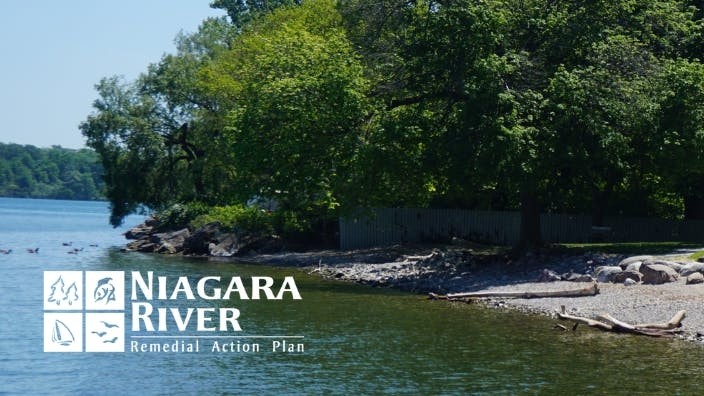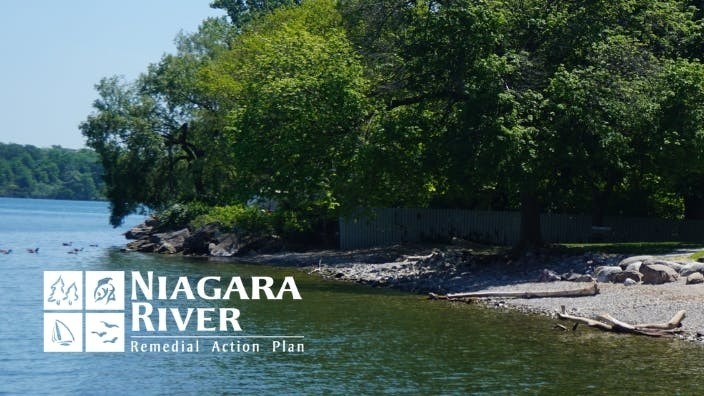Partners Seek Feedback Regarding Niagara River Water Quality Indicator
Water quality at Queen’s Royal Beach in the Town of Niagara-on-the-Lake (Town) has improved thanks to local agencies and partners working together on the Niagara River Remedial Action Plan (RAP).
The Niagara Peninsula Conservation Authority (NPCA), the agency that coordinates the RAP program with several partners including the Town, is seeking public input on the recommendation to change the status of the Niagara River’s water quality indicator related to the beach. This recommendation is based on a recent report indicating that cleanup actions and goals have been achieved and affirms progress being made to improve the river.
Queen’s Royal Beach is the only public swimming beach along the Canadian side of the Niagara River and is a popular place for sightseeing, wading, and as a put-in for kayaks and paddleboards. Historically, the beach was often impacted by poor water quality due to E. coli bacteria, which in high amounts can make people sick if they swim in it.
“The Town recognizes the importance of protecting this beach and waterfront for its residents and visitors,” says Marnie Cluckie, Chief Administrative Officer at the Town of Niagara-on-the-Lake. “Queen’s Royal Beach is a vital asset that contributes to the health and well-being of our community, the environment, and the local economy.”
Bacteria can come from natural sources such as birds and other wildlife or human sources like sewer pipes. Previous scientific studies indicated that there were human sources of E. coli bacteria coming from a storm sewer outlet near the beach.
Thanks to funding from the federal and provincial governments and leadership from the Town with other local partners, extensive monitoring and remediation actions were completed (e.g., fixing sewers, preventing racoons from entering storm sewers and constructing a nature-based filtration bioswale) to reduce the main sources of E. coli bacteria entering the Niagara River and impacting Queen’s Royal Beach.
“Because of these important collaborative contributions, the water at the beach has consistently met RAP water quality goals for the last 3 years,” says Natalie Green, project manager at the NPCA. “The proposed status change is a tremendous milestone for the community and all RAP partners as it’s another step toward removing the Niagara River from the list of Great Lakes’ Areas of Concern”.
Since the late 1980s, the Niagara River has been identified as one of 43 severely degraded locations in the Great Lakes, called Areas of Concern, that require a Remedial Action Plan. The NPCA has been an active participant in the Niagara River RAP since its inception and became the host organization for coordinating RAP activities in 1999. The Niagara River RAP partners continue to work together on remaining actions necessary to address issues related to fish consumption advisories, the degradation of fish and wildlife populations, contaminated sediment in the watershed, and habitat loss.
A short survey and online engagement tool are now available at getinvolved.npca.ca/niagara-river-beach until August 6, 2021. Members of the community are encouraged to participate in this important process through the available online mediums. Accommodations can be made upon request for non-virtual methods such as a paper or telephone survey.
To learn more about the Niagara River RAP and how to get involved, please visit: www.ourniagarariver.ca/beach or call 905-788-3135 x327 Follow on Instagram, Facebook, Twitter for more updates.
-30-
About the Niagara River RAP:
The Niagara River Remedial Action Plan (RAP) is a community-based partnership between government (federal, provincial, municipal), First Nations, Métis Nation of Ontario, the NPCA, non-government organizations, scientists, and interested citizens working together to restore and protect the Niagara River’s water quality and ecosystem health. Learn more at www.niagarariver.ca
This Niagara River RAP initiative is implemented, in part, with the financial support of Environment and Climate Change Canada and the Ontario Ministry of the Environment, Conservation and Parks.
About NPCA:
The Niagara Peninsula Conservation Authority (NPCA) is a community-based natural resource management agency that works to protect, enhance, and sustain healthy watersheds. With 60 years of experience, the NPCA offers watershed programs and services that focus on flood and hazard management, source water protection, species protection, ecosystem restoration, community stewardship, and land management.
The NPCA is one of 36 Conservation Authorities in the Province of Ontario and manages 41 Conservation Areas within the Niagara Peninsula watershed held in public trust for recreation, heritage preservation, conservation, and education. These natural and shared greenspaces marry nature, culture, and adventure to create limitless opportunities for discovery.
Questions about this release should be directed to:
Erika Navarro-Meza, Communications Specialist
Niagara Peninsula Conservation Authority
905-650-4027 | enavarro@npca.ca

